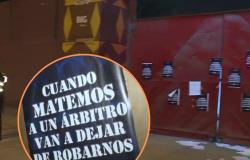1989 was a year hinge, which changed the world forever. It was the period in which the Berlin wall fell and began to be heard about the existence of the World Wide Web, which would later be known as the Internet. In our country, things were not very good: it was the time of Alfonsin’s hyperinflation, which forced him to deliver his mandate to the “caudillo” that came from La Rioja. It is not necessary to provide more details about who we mean.
Gualeguaychú, at that time, was a quiet place, without major shocks, where the growing city was mixed and the idiosyncrasy of a town that resisted to leave, or resign, certain behaviors that made it their own. Undoubtedly, a place that has currently been able to commune these two issues: to be a city and town at the same time.
But even in the most remote places on the planet, “where nothing never happens”, there are days that are stored in the memory of its inhabitants, and to this day there are those who remember what happened with Jaisal Alejandro Adón.
Horrendous and spooky
Those were the terms that were used in the newspapers to hold on Friday, August 25, 1989 about the murder of the retired inspection commissioner of the Entre Ríos Police that the day before had been found lifeless inside his home on San José 226 street, between San Juan and Ituzaingó.
For that moment when the newspapers made public what had happened, the news was already running as a gunpowder through the city. The radios, which did not have to wait so long to give details of what happened with Adón, followed the minute by minute of an investigation that was initially closed and mysterious. Nothing knew about the mobile of the terrible crime.
Jaisal Alejandro Adón was 68 years old when on August 23, 1989 he opened the garage door of his house and was attacked with a romo element (without tips) and forceful, which destroyed his skull. His body was thrown next to Citröen that was stored in the place.
Adón had been a deputy chief of the Departmental Headquarters of Concordia and his son, Héctor Alejandro Adón, who was a major inspector in 1989, was in charge of the same Headquarters in which his father had exercised years before, for which, what happened in Gualeguaychú hit the entire police family strongly.
Initially the mobile of the theft had been discarded by two issues. On the one hand, the door was not violated, so it was established that the victim knew his murderer, whom he opened without suspicion of what would happen, and on the other hand the only thing that was confirmed that he was missing in the house was a videocasetera, and that everything else was in his place and there was nothing scrambled.
Then, the investigation was initially oriented to some other issue, such as revenge or something like that, but that video store that was missing would play a key role in the progress of the cause and allowed to reach the authors of the fact. Or at least the author, which is even what is confirmed today.
dry Pasto
Around 10 pm on Wednesday, August 23, the attack occurred, but it is believed that Jaisal Adón agonized about an hour. When they found him the morning of the next day, he had managed to drag a few meters to the access door of the house on San José Street. It had an average placed “to the throat.”
With the passing of the hours it was confirmed that not only had a videocasetera taken, but also a sum of money and a couple of gold rings, which added more than one million Australs (the Argentine currency of those times). But he was already beginning to talk about “the murderers”, because given the modality of crime it was believed that more than one person had acted in the crime.
For Saturday 26 there were already three people arrested, but only one of them was the one that was finally charged. It was a 20 -year -old, known as “dry grass” in reference to her hair. Néstor Arturo Antonio Quintana was arrested for having in his possession the Adón video store. They found her at her domicile Daello Jurado 1168, almost Rocamora.
The instruction judge, Celestino Toller, was the one who was in charge of the investigation and as was common in those years and until 2013, the same magistrate who directed the cause and charged the suspect, was the one who was in charge of supplying the guarantees. A somewhat “schizophrenic” role, as it knew how to qualify another Judge of Instruction of Gualeguaychú.
Quintana always remained silent. He never opened his mouth. Although there were suspicions that he had not acted alone, this 20 -year -old decided not to declare. And that’s how he came to trial. Without taking responsibility and without involving third parties. But that would change years later when in the debate in Gualeguay gave its version of the events and involved two former police officers.
Toller accused him of aggravated homicide in real contest with simple theft. Preventive detention was issued and for security reasons he was transferred to the Criminal Unit No. 7 “Dr. Casiano Calderón” of Gualeguay until the beginning of the trial that began on April 27, 1992.
Two police officers involved
The Gualeguay Chamber for this trial was composed by Alberto Ramón Lesca, Eclio Alberto Dumón and Carlos Alberto Pabón Ezpeleta. These three judges were responsible for listening to the large number of testimonies that were contributed to the case by the judge of Gualeguaychú.
Between Monday 27 and Tuesday, April 28, 1992, they declared three experts and 14 witnesses, but the magistrates had an intermediate room until May 8 because they understood that the presence of a young man who was pointed out as the person in charge of selling the videocasetera that had been subtracted from Adón’s house was necessary, but as that person lived in Buenos Aires or in the south of the country it was necessary to locate it first and then transfer it to Gualeguay declare. Likewise, his presence did not add anything important to what already had.
Until that time, one of the most significant statements had been that of Héctor Alejandro Adón, son of Jaisal and Chief of Police of Concordia. This man said to meet Quintana and said that the young man knew the movements of the house; And he knew his father lived alone. He even revealed that the victim had told him a few days before the accused had attended the house of San José street next to a relative, with the excuse that he wanted to enter the police.
He also reported that Quintana had the prohibited entry to a dance bowling alley for a violent reaction that he had and that in one occasion his own sister had threatened to death.
But the most important thing came later, when the trial resumed on May 8. That was the day when Quintana decided to speak on the advice of her lawyer, Virgilio Cardozo. Two years and new months after the fact he said he had not spoken “for fear of reprisals by people who ultimately like authors.”
He said that on August 23, 1989, around 20, he was next to Jaisal Adón in the sidewalk of the house and from there they passed one of the rooms. They were sitting in an armchair, watching television and talking for half an hour, when they played the bell of the house. Adón attended through the garage door, and immediately heard people running.
In his statement he mentioned that he saw the victim lying on the garage floor and two former police officers who knew and described with name and surname. He said that one had a tool in his hand and the other had a weapon. When they saw him they approached him, and he who had the weapon took him by the hair and said: “Stay calm, nothing will happen to you.”
He said he managed to escape when they carried him for an inner apartment that sometimes occupied Adón’s son when he reached Gualeguaychú. He could get rid of the man who had him taken and through a door that was open he escaped. After there he went to the Campostrini bar, took an “orange” and went home.
But the story did not end there. To explain what happened with the video store, he said he took the bag with football elements and went to his girlfriend’s house. He got into a collective and as he knew the collective, he would have offered the device to watch movies and Take it. “Take her,” the collective would have told him, but Quintana could not go down in his girlfriend’s house because there was a lot of mud and that’s why he returned home with the video toll in his possession. A story too strange.
He said that only the next day he learned of Adón’s death and that he said nothing out of fear. The next day, that is, on Friday 25, he learned that the victim had stolen the videocasetera and then remembered the collective. As he knew him took her to return it. Quintana fell detained when the collective marked him as the person who had wanted to sell the video toll.
In his allegation, prosecutor Antonio Cirigliano listed one by one the inconsistencies in the story of Quintana and stressed that it was not only the fact of the videocasetera that implied Quintana in the crime. In his statement he confirmed that he was present in the crime, but another of the points he committed it was that a shoemaker hammer that he had in his possession and a “cowboy” jacket, had blood compatible with that of the deceased; And that despite the fact that adidas shoes and the bag were washed, they also had a vestige of blood.
Another of the evidence that committed it has to do with the hairs that were found in the average Adón had in his mouth. They were coinciding with other traces that were collated to those found in the Quintana jacket.
Proven, with degree of certainty
For justice there were no doubt regarding Quintana’s participation in the case. The only question that remained answered was if he had acted alone; And this never clarified with the degree of certainty that is needed and that is why Quintana was the only accused and sentenced to 13 years in prison.
There was a mobilization asking for the freedom of Fifth, after being convicted. This was based on the sentence of the cameramen who agreed that Quintana did not act alone.
That mobilization asking for the freedom of the convicted person was carried out in front of the municipality, and it was the officials of that moment who received the relatives. Councilor Ernesto Mindeguía, the Secretary of Public Works, Pablo Baffico, and the Secretary of Government, Ricardo Irigoyen heard the claims and complaints that were aimed at investigating the two former police officers who had been appointed by Quintana in the trial.
It was called the march of silence, in clear resonance with what happened in other parts of the country, mainly with what happened with María Soledad Morales in Catamarca, which was killed in September 1990. “An almost unpublished fact, since in Gualeguaychú there is no other mobilization of these characteristics,” wrote the newspapers of that time.
Néstor Quintana’s mother denounced before the journalists’ engravers: “We want justice to be done. My son who is detained was not guilty of what happened, he simply witnessed the fact. And to the people that Nestor appointed in the trial, we want them to stop them and investigate them, because it is not fair that we live with these people.”
Nothing happened with this and there was a judicial cross among the former police officers appointed in the trial and in the media with the mother of the conviction who had no empacho in pronouncing a name and surname before the journalists in the mobilization. But the truth is that nothing happened judicially with these two men.
The only thing that history portrays was Quintana’s conviction. After remaining a short period of time in the Gualeguay prison, after the conviction he was transferred to Criminal Unit 2 of Gualeguaychú to turn with the 13 years. It was learned that he maintained a good behavior and with the two thirds of the sentence fulfilled, he began his transitory exits until he finally regained freedom.
The so -called Adón Case was one of the most remembered police events in Gualeguaychú.





